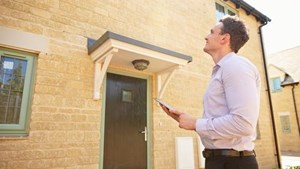Do I need a survey when buying a house?
8 minute read

Buying a home can cost a lot of money, which you’ll likely be paying back over many years. It’s important that you make the right decision and choose the property that you’ve not only fallen in love with but that is suitable to live in and in good condition. This is what a survey can do for you.

Age Co Insurance
We offer products and services to help the over 50s get more out of later life and give our profits to the charity Age UK.
Are house surveys worth it?
House surveys are very important as they can show the condition of a property and even flag information that may concern you enough that you decide not to progress with the purchase, such as dry rot, subsidence, and more.
If you do want to proceed with the purchase but you’re worried about the survey results, you may be able to use the information to negotiate the price of the property down.
Who organises a survey when buying a house?
If you’re the one purchasing the property, it’s down to you to organise the survey.
You can ask for a recommendation from your solicitor, who will likely know a few reputable people that are part of the Royal Institution of Chartered Surveyors (RICS). Alternatively, you can do some research of your own. It’s important that the surveyor is part of the RICS or the Residential Property Surveyors Association (RPSA), accrediting bodies for surveyors.
What does the seller ever need to organise a survey?
If you’re selling the property, you don’t need to provide a survey for the buyer. The only time you may want to look into having a survey done is if the property is being sold at auction. Sometimes circulating the report to potential bidders before the auction is a good idea, but this isn’t a necessity.
How to arrange a survey on a house
Finding a surveyor can seem daunting, and you want them to be trustworthy and reliable. This is often why a recommendation from a trusted source is often preferred, such as from your solicitor or family member.
Alternatively, you can use the RICS’ useful tool to find a surveyor near you. Once you’ve found the surveyor that seems most reputable and is local to you, you can give them a call or email to ask when they can arrange a home visit.
The survey may need to be paid for upfront or, in some cases, can be added to your solicitor’s bill to be paid when the contracts have been signed and exchanged.
Types of house surveys
If you’re worried about the cost, there are different types of surveys that you can choose from that vary in price. Some are more basic and will be cheaper, whereas others are more detailed and therefore more expensive.
The RICS Home Survey – Level 1
This is the most basic survey and is generally recommended for commonplace homes, such as standard houses, flats, and bungalows. You should have a strong sense that the property is in good condition and there shouldn’t be any unusual design features or building materials in use.
What’s included
- A low-level visual inspection (less thorough than those carried out for Level 2 and Level 3 surveys)
- A report that uses a traffic light system to determine whether any issues found are serious (red), a cause for concern (orange), or ok (green)
- A summary of risks to the building, occupants, and grounds
- An assessment of the relative importance of the defects and problems that have been found
Not included
- Tests to confirm the quality of the building fabric or services
- Advice on what repairs is needed
- Guidance on the required ongoing maintenance
- A monetary valuation of the property
The RICS Home Survey – Level 2 (survey only)
This survey offers more detailed information than the Level 1 counterpart but should still only be used for conventional property types that seem to be in reasonable shape.
What’s included
- A more thorough visual inspection, which will include concealed areas, such as roof spaces and basements
- A report that uses a traffic light system to determine whether any issues found are serious (red), a cause for concern (orange), or ok (green)
- A summary of risks to the building, occupants, and grounds
- An assessment of the relative importance of the defects and problems that have been found
The report included in a Level 2 survey will contain information like that of Level 1 but with additional details. These could be broadband speed, damp assessment, and previous boundary disputes.
Not included
- Tests to confirm the quality of the building fabric or services
- Advice on what repairs is needed
- Guidance on the required ongoing maintenance
- A monetary valuation of the property
The RICS Home Survey – Level 2 (survey and valuation)
As the name suggests, this survey will include everything listed in the above Level 2 survey – plus information relating to the value of the property. This can be a worthwhile add-on if you want to understand how the value of your purchase may change over time or if you simply want to ensure you’re paying a fair price.
The valuation included in this package will typically cover:
- A professional opinion on the current market value of the property
- How any uncovered problems may affect the property’s value in the future
- An insurance reinstatement figure
The RICS Home Survey – Level 3
A Level 3 survey is the most extensive variety and therefore will be the most expensive to undertake.
Once referred to as a full or structural survey, they’re typically recommended for older properties or more unusual buildings, such as those with a listed status. You might also consider this option if you plan on undertaking any large-scale alterations, as the report included here will include details on recommended repairs and maintenance concerns.
What’s included
- An extensive visual inspection of the building, services and grounds that will also include a more thorough report on concealed areas (basement and loft) than the one offered for Level 2
- Your surveyor will check that your services are in normal operation if it is safe to do so and the occupier gives permission*
*Please note: this is not a full test but will try to confirm basic functionality.
The report provided will offer the same traffic light detailing as the other levels. On top of this, your final assessment will also include:
- Risks that your surveyor beliefs may be present in areas of the property that are inaccessible
- An assessment of how the faults found may have been caused
- An outline of how issues may be fixed, as well as what the consequences could be if they go unattended
- Your surveyor should also give some recommendations on what repairs you should focus on first and the timescales involved
- Some surveyors may also provide cost estimates for the work required, though this service should be agreed upon in advance
Not included: Level 3 surveyors do not automatically include a valuation. It is likely you’ll need to pay for this as an additional service.

What happens after a survey on a house?
Once the surveyor has been to your house, they’ll usually send you a report within a few days – though timings can vary, especially if demand is high. This report should give you an overview of the property, any potential problems, and their implications. If required, you can ask them to go through it in more depth or clarify certain aspects.
What to do if an issue is found during a house survey?
If an issue is found, you may want to take some time to assess whether you want to go ahead with your property transaction. You may even want to consider getting a second opinion. For example, if an issue was found during a Level 1 survey, you might choose to proceed with a Level 2 or 3 to get more details.
Should you decide to proceed, it is worth talking to the current owner to see if they are able to solve the issues themselves and do this before you’re due to exchange contracts. Don’t forget to ask for proof that the work has been completed and receipts to show the cost of the work before you exchange. You want to make sure they’ve done their part and completed the work that they agreed to.
If these issues cannot be fixed ahead of time, then it might be worth revising your accepted offer and renegotiating a lower price. To do this, you should get a quote for how much it will cost to fix the flagged problems. For example, if it is estimated to cost £5,000 to fix a fault with the roof, then you could try to negotiate for this to be taken off the current offer.
However you decide to proceed, don’t forget it’s important to take out home insurance, ideally before your exchange date. This is because, should an incident occur even before you move in, your home will be protected and you won’t incur additional costs to cover the damage caused.
Summary
Getting a survey is an important step in buying a property. If you're unsure about the process, consider these key points:
- House surveys are important as they help you understand the condition of the property you're purchasing.
- If you discover the house you're purchasing has faults, you may decide to pull out of the sale or renegotiate the price.
- It is up to you, the buyer, to organise the survey with a Royal Institution of Chartered Surveyors (RICS) accredited surveyor.
- There are various types of surveys available, ranging in price and level of detail - if you're unsure which is best, try discussing your options with your solicitor.

Sign up to the Age Co Newsletter
Each month, our email newsletter delivers inspiring stories, practical guides to later life, plus the latest news about Age Co and the charitable work we support.
